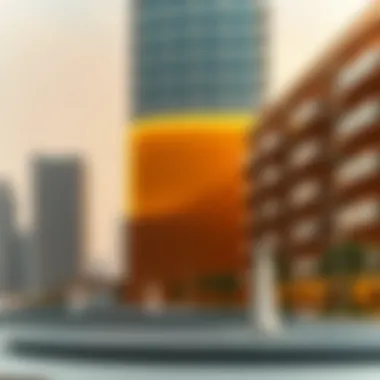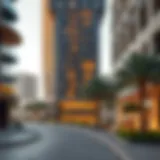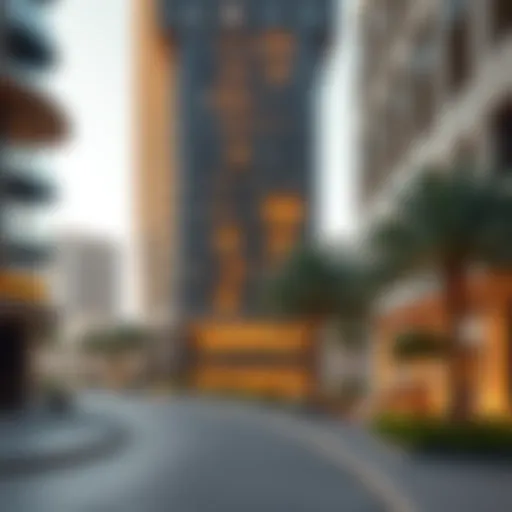Understanding توجيه القوز: Urban Planning in Dubai


Intro
Urban development is a constantly evolving field, especially in dynamic cities like Dubai. One of the cornerstones of this evolution is توجيه القوز, a regulatory framework that shapes urban planning in a city known for its ambitious architectural feats and vibrant neighborhoods. Understanding توجيه القوز is essential for anyone involved in the real estate sector, whether you’re an investor eyeing opportunities or a resident navigating the changes in your community.
As Dubai continues to grow, its real estate market is witnessing rapid transformations driven by economic shifts, population growth, and new regulations. This article delves into the implications of توجيه القوز, examining how it affects real estate prices, investment strategies, and the overall landscape of Dubai's neighborhoods.
In the following sections, we will provide valuable insights into the market trends currently shaping the real estate scene in Dubai, bring clarity to the complexities of buying versus renting, and explore the financing options available to prospective property owners. For investors, developers, and expatriates alike, comprehending the nuances of توجيه القوز is imperative for making informed decisions in this vibrant market.
Preface to توجيه القوز
Tawjeeh Al Qouz stands at a critical juncture in the evolution of urban planning in Dubai. To truly grasp the city’s architectural landscape, one must delve into this guiding principle, which emphasizes sustainability, integrity, and innovation. This section is crucial not just for understanding regulations but for discerning the very essence of neighborhood dynamics and growth trajectories in Dubai.
Definition and Overview
At its core, توجيه القوز is a regulatory framework designed to streamline urban development while maintaining a unique identity and cultural resonance. It lays down specific guidelines that dictate land use, development densities, and architectural aesthetics within certain districts. These stipulations serve multiple purposes: they promote orderly growth, enhance community livability, and ensure that developments stay true to Dubai's vision of becoming a global hub.
Imagine a vibrant neighborhood where every corner reflects thoughtful planning, where parks are easily accessible, and public transport seamlessly connects every nook. This is the vision encapsulated in توجيه القوز. By focusing on holistic urbanism, it aims to create spaces that foster connection, well-being, and sustainability.
Historical Context
To understand توجيه القوز, one must consider its historical backdrop. In the late 20th century, Dubai encountered rapid population growth and urban expansion, leading to overdevelopment in haphazard manners. This posed unforeseen challenges to both infrastructure and the quality of life for residents. Consequently, urban planners embarked on a mission to forge a coherent strategy that could balance development with community needs.
The inception of توجيه القوز in the early 2000s marked a pivotal shift. It was first showcased through various pilot projects, setting the architectural tone for future developments. The evolution of this framework reflects a responsive approach, adapting to the changing needs of the city while remembering its roots. This careful balancing act emphasizes the importance of integrating community input, historic preservation, and practical frameworks into urban planning.
"Urban planning is not just about buildings; it's about nurturing vibrant communities and fostering connections."
Thus, توجيه القوز has emerged as a guiding light in Dubai’s quest for sustainable and organized urban development. Investors, developers, and residents alike are now looking closely at how these principles play out in real estate opportunities and community experiences.
The Significance of Urban Planning
Urban planning serves as the backbone of sustainable development, especially in rapidly growing cities like Dubai. The importance of urban planning cannot be overstated; it lays out the blueprint for organized growth, ensuring that every aspect of city life, from transportation to housing, is thoughtfully integrated. Proper urban planning minimizes chaos, enhances livability, and optimizes land use, making it essential for both current residents and future generations.
In Dubai, the significance of urban planning is particularly prominent due to the city’s ambitious vision and accelerated development pace. Here, strategic planning is not just beneficial; it’s a necessity.
Role of Urban Planning in Dubai
The role of urban planning in Dubai extends beyond mere layout designs. It encompasses a wide array of functions that directly affect the daily lives of residents and the operational efficiencies of businesses. Some key roles include:
- Guiding Development: Urban planning ensures that real estate development aligns with the broader objectives of the city. It fosters coherent development that considers both residential and commercial needs.
- Promoting Accessibility: Through strategic zoning and transport planning, urban planners work to promote connectivity. Whether it’s the placement of metro lines or the construction of roads, these decisions greatly improve the mobility of residents and the accessibility to services.
- Enhancing Community Welfare: A well-planned urban space prioritizes parks, schools, and hospitals, which are essential for community well-being. The focus on creating public spaces fosters a sense of belonging and community.
- Driving Economic Growth: By creating an appealing environment for businesses, urban planning directly influences investment attractiveness. Areas that are effectively planned are more likely to draw in international investors, boosting local economies.
This nuanced approach underscores the critical function of urban planning. The planning in Dubai is ambitious, aiming not just to keep pace with growth but to set a benchmark for urban development globally.
Impacts on Real Estate Development
The effects of urban planning ripple through the entire real estate development process in Dubai. Successful urban planning can significantly enhance or impede property values and development prospects.
- Value Appreciation: Areas that have been effectively planned often see significant increases in property values. For instance, when new transportation routes are introduced, the nearby real estate typically experiences a surge in demand.
- Zoning Laws: These laws set the foundation for what types of buildings can be constructed in different areas. For investors, understanding these regulations becomes essential. For example, a mixed-use zoning law could allow for both commercial establishments and residential apartments, making the area more desirable and commercially viable.
- Market Demand: Urban planning shapes the supply and demand dynamic in real estate. As neighborhoods evolve, developers are faced with changing consumer preferences, which requires them to innovate. Residential projects with sustainable features or those integrating smart technology are increasingly in demand.
- Infrastructure Development: Infrastructure improvements often follow urban planning recommendations. Access roads, utilities, and public amenities significantly impact property attractiveness and livability. Properties near major infrastructure or new projects invariably see their value increase significantly.
Overall, effective urban planning is a catalyst for sustainable real estate development. By facilitating structured growth, it not only enhances the living experience in Dubai but also creates lucrative opportunities for investors and developers alike.
Regulatory Framework of توجيه القوز
The regulatory framework of توجيه القوز plays a pivotal role in shaping Dubai’s urban landscape. It is not just a set of rules but a comprehensive blueprint guiding urban development, ensuring that growth aligns with the city's long-term vision. This framework influences everything from zoning laws to infrastructural development, significantly impacting real estate investment strategies and neighborhood dynamics.
Understanding this framework is essential for investors, developers, and residents alike. The clear guidelines it provides help mitigate risks associated with urban development while promoting sustainability and connectivity among neighborhoods. Without this regulation, the urban fabric of Dubai could easily spiral into chaos, undermining the very essence of what makes the city iconic.
Legal Considerations
When we peel back the layers of �توجيه القوز, it becomes clear that legal considerations form the backbone of its effectiveness. Various laws and regulations have been enacted to facilitate responsible urban planning. These include not only land use regulations but also guidelines regarding environmental sustainability, infrastructure development, and community engagement.
For instance, local laws are in place that dictate the types of buildings permitted in specific zones, which in turn affects property values and the type of clientele attracted to an area. Failing to comply with these regulations can lead to significant financial losses and legal complications, making it crucial for all stakeholders to be well-versed in these facets. Legal frameworks often evolve, necessitating continuous monitoring of current legislation. Staying up-to-date with these changes can provide an edge in investment and development, ensuring that one remains compliant while maximizing opportunities.


Implementation and Compliance
Implementation is the next key step in realizing the objectives set forth by the توجيه القوز framework. It’s one thing to have laws in place, and it’s another to see them implemented effectively. Compliance mechanisms are designed to ensure that developers adhere to all relevant regulations, addressing vital aspects such as safety, environmental impact, and infrastructure stability.
Compliance is not a simple check-box exercise; it requires diligence from all parties involved. Developers must often submit detailed plans illustrating how they intend to meet these regulations before obtaining permits. Local authorities not only evaluate these submissions rigorously but also conduct inspections to maintain the integrity of Dubai’s urban fabric. Ensuring that developers follow through on promises made in their applications can safeguard against future complications that might arise from unforeseen consequences.
The success of Dubai’s urban planning largely depends on the collaborative effort of all stakeholders—governments, developers, and residents. It is a delicate dance between ambition and regulation that shapes the city's modern identity.
In summary, the regulatory framework of توجيه القوز offers a framework on which the future of urban development can securely rest. Legal considerations provide guidance, while implementation and compliance mechanisms ensure accountability, making the entire ecosystem perform at its best.
Neighborhood Development Strategies
Urban planning in Dubai, particularly with respect to توجيه القوز, hinges considerably on well-grounded neighborhood development strategies. These strategies shape the city's growth and directly affect the quality of life of its inhabitants, making them essential to the overall development framework. They pave the way for a structured approach to real estate matters, ensuring the evolving urban landscape is both functional and aesthetically pleasing. Additionally, these strategies position themselves as a crucial tool in supporting economic growth, environmental protection, and efficient land use.
Zoning Regulations
Zoning regulations act as the backbone of neighborhood development strategies within توجيه القوز. They dictate the permissible land uses, structure densities, and the heights of buildings that can be constructed in various areas of the city.
Zoning aims to prevent conflicts among different land uses, which can arise when commercial, residential, and industrial spaces are too closely intermingled. For investors and developers, comprehending these regulations is not just about compliance; it’s also about foresight. Knowing what can and cannot be built helps in evaluating the potential of specific neighborhoods.
For instance, an area designated for residential use must maintain its character without commercial interruptions. This zoning ensures that noise, traffic, and pollution from industries do not disrupt the tranquility of homes. On the other hand, commercial zones thrive on foot traffic and easy access, requiring developers to align their projects accordingly.
The evolution of these regulations also reflects changing priorities in urban planning. With a growing emphasis on mixed-use developments that combine housing, shopping, and leisure in a compact area, zoning laws are gradually adapting to permit greater flexibility. This shift can make an area appealing, attracting more buyers and tenants.
Sustainability and Green Spaces
Sustainability is a buzzword that resonates profoundly in the realm of urban planning. Within the context of توجيه القوز, the integration of sustainable solutions and green spaces has become increasingly paramount. As Dubai's population burgeons, the significance of environmentally sound practices and green areas has never been clearer.
Creating green spaces in urban settings offers a myriad of benefits. Not only do they enhance the aesthetic appeal of neighborhoods, but they also promote a healthier lifestyle among residents by providing recreational areas for exercise, leisure, and relaxation. Moreover, these green spaces play a vital role in biodiversity conservation, offering habitats for various species within an urban landscape.
Sustainability goes beyond the mere inclusion of parks and gardens; it encompasses thoughtful design and construction practices that minimize environmental impact. This involves using energy-efficient materials, implementing proper waste management systems, and employing innovative technologies like smart irrigation to conserve water in green areas. Developers interested in long-term returns should prioritize sustainable practices, which can lead to lower operating costs and increased property values.
“Sustainable development is about making strategic choices that meet the needs of the present without compromising the ability of future generations to meet their own needs.”
In summary, the neighborhood development strategies formulated under توجيه القوز are critical for structuring Dubai’s urban environment. By understanding zoning regulations and prioritizing sustainability, investors, developers, and residents can contribute to a thriving, livable city that meets the needs of its population and preserves the environment for years to come.
Current Trends in توجيه القوز
Current trends in توجيه القوز reflect the evolving landscape of urban planning in Dubai. These trends are critical for investors, buyers, developers, and expatriates, as they influence real estate projects and community dynamics. Understanding these trends can be the difference between a successful investment and a missed opportunity.
Emerging Neighborhoods
As Dubai rapidly urbanizes, new neighborhoods are popping up like mushrooms after a rain. These areas are characterized by modern design, smart technology, and vibrant social spaces. One standout neighborhood is Dubai Science Park, aimed at hosting innovative businesses in the science and technology sector. It’s not just about having a roof over one’s head; it’s about creating a community that fosters interaction, creativity, and business growth.
Another noteworthy example is Dubai Design District. Conceptualized as a hub for creativity and innovation, this neighborhood attracts artists, designers, and tech enthusiasts. It illustrates how urban planning has shifted from being merely functional to nurturing a dynamic lifestyle.
Investors looking to enter these emerging communities also need to consider their unique characteristics. For instance, Al Quoz Creative Zone is not just about potential returns; it’s also about participating in a cultural renaissance. The blend of art galleries, cafes, and shops gives this area a nurturing environment for both residents and businesses.
Technological Innovations
Technological advancements are also reshaping the framework of توجيه القوز. The implementation of smart city technologies in urban planning cannot be overstated. For instance, the use of Internet of Things (IoT) devices in community management allows for real-time data collection and efficiency improvements. Sensors placed throughout neighborhoods can monitor traffic patterns, energy consumption, and waste management—essentially giving urban planners a leg up on data-driven decisions.
Moreover, projects like Dubai Land Department’s Smart Services are revolutionizing how real estate transactions happen. The aim is to reduce red tape and streamline the buying and selling processes, thus attracting more foreign investment. Prospective buyers will find that the ease of transactions is increasingly favorable.
In addition to operational functionalities, technological innovations spearheaded by the Dubai 10X initiative push for a forward-thinking approach to urban growth. This strategy seeks to position Dubai ahead of other global cities by integrating advanced technologies into urban planning methodologies.
"In the race of urban development, technology isn’t just a tool; it’s the fuel that drives progress."
Investors and developers are well advised to stay ahead of these trends to capitalize on opportunities while minimizing risks. Understanding the technological landscape and the emerging neighborhoods will provide insights into understanding future market shifts.
Investment Opportunities


Investment opportunities in urban planning hold significant weight, especially when navigated through the evolving landscape of توجيه القوز in Dubai. For investors and developers, understanding the dynamics of this regulatory framework opens doors to promising ventures. The very fabric of Dubai’s urban development is interwoven with strategic planning and foresight. As such, the implications of توجيه القوز not only influence property values but also dictate the rhythm of market trends and community stability.
High-Potential Areas
Dubai is a city of contrasts, where innovation meets tradition. High-potential areas for investment are often borne out of projects that reflect the emirate's ambitions. Locations like Al Quoz and surrounding neighborhoods are emerging as promising hotspots. These areas benefit from infrastructural enhancements and support from the local government aimed at revitalizing urban spaces.
The real estate market is increasingly gravitating towards:
- Mixed-use developments: These are particularly appealing as they blend residential, commercial, and recreational spaces.
- Sustainable projects: Earth-friendly buildings are gaining momentum. Investors can tap into this growing sector, aligning with global green trends.
- Cultural hubs: Spaces promoting arts and community engagement are critical. Investing in cultural developments often leads to higher returns as they foster community involvement.
"Investing in high-potential areas isn't just about picking a spot on the map; it's about understanding the pulse of the community and its future plans."
Risk Assessment
Entering the investment landscape without a clear understanding of risks can leave one in a precarious position. Therefore, undertaking a comprehensive risk assessment is crucial. The unpredictability of the market—especially in a fast-paced environment like Dubai—means that investors must remain vigilant.
Key risks to consider include:
- Market Volatility: Fluctuations in demand can significantly affect property values. Keeping an eye on market trends and economic indicators is essential.
- Regulatory Changes: Given the dynamic nature of توجيه القوز, changes in policies can have immediate effects on development viability.
- Community Sentiment: The local populace's attitudes toward new developments can influence market acceptance. Engaging with community feedback mechanisms can help mitigate this risk.
Investors should also employ analytical models to predict market shifts, considering historical data and potential future developments.
By placing emphasis on these investment opportunities, including identifying high-potential areas and austerely assessing risks, stakeholders can not only navigate but thrive amid the intricacies of Dubai's urban planning strategies. This thorough understanding ultimately fosters resilience and innovation in the face of urban challenges.
Challenges Faced in Urban Development
Urban development in Dubai stands at a crossroads where ambition meets reality, paving lanes through both opportunities and obstacles. Understanding the challenges faced in urban development is pivotal not only for developers but also for investors and residents alike. As Dubai navigates its growth amidst a rapidly changing environment, these challenges shape the architectural and socio-economic landscape of the city.
Market Volatility
The bustling real estate market in Dubai is no stranger to fluctuations. Market volatility represents a significant hurdle for developers and investors. Prices can swing like a pendulum, influenced by various factors such as economic conditions, geopolitical stability, and global market trends. For instance, during the oil price slump, the Dubai property market experienced a downturn, showcasing how deeply intertwined local developments are with global economic shifts.
Investors need to remain vigilant about these fluctuations. Understanding historical data and market trends is crucial. By employing comprehensive risk assessment strategies, stakeholders can navigate potential downturns more effectively. Tracking developments in key sectors, such as tourism and trade, can provide insights into future property demand. In contrast, a decline in these sectors might spell trouble for real estate values.
Key points to consider regarding market volatility in Dubai:
- Economic Indicators: Pay close attention to GDP growth rates and oil price changes.
- Buyer Preferences: Shift in demographics, particularly with expatriates, affects demand for housing.
- Regulatory Changes: Government policies can either tighten or loosen the market, impacting investor confidence.
To sum up, the challenge posed by market volatility requires a proactive approach from all parties involved. Adapting to ever-changing conditions may be demanding, yet those who do could find golden opportunities within uncertainty.
Regulatory Hurdles
Dubai’s ambitious urban planning brings a patchwork of regulations, which can often be daunting. Navigating through regulatory hurdles is not merely about understanding laws but also about aligning with the city’s intricate urban plans. One prominent challenge is the degree of compliance required by various authorities, such as the Dubai Land Department and the Dubai Municipality.
Inconsistencies in regulations can lead to misunderstandings or delays in project timelines, causing significant financial implications for developers. Moreover, the % shifting legislative landscape adds complexities that can catch even seasoned investors off guard.
Some common regulatory hurdles include:
- Permitting Delays: Obtaining necessary permits could take longer than expected, especially in high-demand areas.
- Construction Costs: Rising material and labor costs, compounded by stringent regulations, create financial strains.
- Sustainability Requirements: As Dubai embraces smart city initiatives, developers face increased expectations for eco-friendly practices.
The influence of these regulations cannot be understated. Not only do they impact timelines and budgets, but they also shape the ultimate vision for urban space in Dubai. Enduring these challenges requires staying informed about current regulations and trends in urban planning to ensure projects align with the city’s long-term goals.
“The architects of tomorrow will need to master today’s regulatory realm to turn ideas into livable realities.”
Future Directions of توجيه القوز
The concept of توجيه القوز plays a critical role in shaping Dubai's urban environment and its evolution as a global metropolis. Understanding the future directions of this regulatory framework provides insights into how urban planning can effectively cater to the needs of a growing population while still promoting sustainable development. As the landscape changes, the significance of strategic planning becomes apparent, serving both current residents and future inhabitants.
Vision for Dubai's Urban Landscape
Looking ahead, Dubai aims to transform its urban landscape through توجيه القوز into a model of modernity and sustainability. Stakeholders envision a city where residential areas are not just places to live but are part of a broader ecosystem that integrates commercial, recreational, and cultural amenities. This holistic approach aims to enhance the quality of life while driving economic growth.


Several key elements are crucial to this vision:
- Sustainability: Efforts to incorporate green building practices and renewable energy sources will minimize the environmental impact. Parks and open spaces will be prioritized to foster biodiversity and provide recreational areas for residents.
- Smart Technologies: Incorporating smart city technologies will create a more efficient urban environment. Intelligent transportation systems and data-driven public services will improve mobility and accessibility.
- Community-Centric Development: The focus will shift towards creating spaces that encourage social interaction and community events. This transformation prioritizes public spaces where residents can engage, fostering a sense of belonging.
"The future of urban development hinges on our ability to interweave modern technologies with an understanding of community needs."
Long-Term Planning Initiatives
In the realm of long-term planning, توجيه القوز emphasizes initiatives that prioritize both current and future development demands. The goal is to create a versatile urban environment that adapts to socio-economic changes while addressing the challenges brought about by rapid population growth.
The following strategies outline the long-term initiatives under consideration:
- Investment in Infrastructure: Upgrading transportation networks, utilities, and public services is vital for supporting the increased demand from new developments.
- Smart Growth Principles: Using principles of smart growth, the planning frameworks will encourage density, mixed-use developments, and pedestrian-friendly zones, reducing reliance on cars.
- Engagement with Local Communities: Long-term planning will also involve greater participation from local residents, ensuring that development reflects their values and aspirations.
The future of توجيه القوز in Dubai ultimately lies in its adaptability to changing urban dynamics. This approach fosters not only a robust urban landscape but also a step towards a sustainable and integrated community living.
Community Engagement in Urban Planning
Community engagement is a cornerstone of effective urban planning, particularly in the context of توجيه القوز. This section emphasizes the crucial role that local communities play in shaping their environment. In Dubai, where rapid development meets a diverse populace, engaging residents in the planning process is not merely a nicety, but a necessity. Understanding the local context enables planners to make informed decisions that resonate with community needs and aspirations.
Engagement can take many forms, from public consultations to collaborative planning workshops. Each method brings unique benefits to the table, ensuring that voices from all walks of life are heard. This leads to decisions that not only reflect expert opinions but also align with the realities and desires of those who live and work in these neighborhoods. Importantly, community engagement helps to foster a sense of belonging and ownership among residents, transforming them from passive observers into active participants in the development process.
Additionally, as the city continues to grow, considering various community viewpoints can aid in identifying potential challenges early on. It allows for a more holistic approach to urban development, reducing conflicts and ensuring smoother implementation of projects. Thus, a proactive approach in engaging the community serves both practical and ethical imperatives in urban planning.
Stakeholder Involvement
In any urban planning initiative, particularly one as dynamic as توجيه القوز, involving stakeholders is paramount. Stakeholders can range from governmental bodies, real estate developers, and local businesses, to residents themselves. Each group brings its unique perspective, knowledge, and expectations to the table.
"When many hands are at work, the outcome is typically far richer."
For instance, developers can provide insights into market trends and technical feasibility, while residents can articulate their daily experiences and unexpected needs. This blend of expert and lay perspectives can drive innovative solutions in urban design and policy.
Moreover, effective stakeholder involvement serves to build trust, ensuring that developments meet practical needs while respecting the community’s cultural and social fabric. Regular forums, surveys, and collaborative meetings can lay the groundwork for a more inclusive planning environment.
Public Feedback Mechanisms
Establishing robust public feedback mechanisms is a vital component of community engagement. These systems not only collect input but also communicate to citizens that their voices matter. In the context of توجيه القوز, feedback can shape everything from zoning laws to public amenities, making it an essential tool for enhancing satisfaction and community well-being.
Methods of gathering feedback can vary. Social media platforms, town hall meetings, and dedicated websites with surveys or suggestion boxes have become popular avenues. By utilizing both traditional and modern techniques, planners can ensure maximum participation from the diverse demographic that constitutes Dubai’s population.
Additionally, transparency is key to maintaining public trust. When feedback is considered and acted upon, it fosters a culture of cooperation. Conversely, when input is ignored, it can lead to resentment and disengagement.
End
The conclusion serves as the crucial capstone of this article, encapsulating the intricate layers of discussion surrounding توجيه القوز. While each section has laid out a specific facet of Dubai's urban planning and its ramifications on real estate and community engagement, this final segment ties everything together, reinforcing the article's key messages.
In summing up, it’s essential to recognize the strategic importance of توجيه القوز within the broader context of urban development. As Dubai continues to evolve amidst rapid urbanization, having a solid regulatory framework becomes indispensable for fostering sustainable investment and community well-being. Investors and developers gain a roadmap for navigating the complex landscape of real estate in the Emirates, ensuring they align with the city’s long-term vision.
Moreover, as discussed earlier, community engagement emerges as a vital component. The collaborative dialogue between stakeholders enhances transparency and builds trust, which are essential for successful neighborhood development.
Key insights reveal that:
- توجيه القوز is a tool for transformation, enabling effective land use while accommodating the needs of future generations.
- Policies promoting green spaces and sustainability are not merely nice-to-haves; they are necessities as urban environments face environmental pressures.
- Technological advancements in urban planning further support smart, efficient development strategies that can adapt to changing demographics and market trends.
Investors must keep these insights at the forefront of their decision-making processes. Comprehending the dynamics at play in the regulatory framework can lead to more informed choices that align with both short-term gains and long-term sustainability.
As Dubai strides into the future, the implications of توجيه القوز resonate beyond real estate markets, reflecting a broader commitment to creating livable, thriving urban spaces.
Summarizing Key Insights
In reviewing the essential facets outlined in this article, several points crystallize:
- Urban Planning Significance: The strategic role of توجيه القوز in shaping the urban landscape of Dubai cannot be overstated. It’s a blend of tradition and modernity.
- Investment Benefits: Understanding market trends, regulatory nuances, and community needs equips investors with a competitive edge.
- Challenges and Opportunities: Recognizing the market’s volatility and regulatory challenges can inform decision-making, paving the way for successful investments.
Final Thoughts on توجيه القوز
To conclude, توجيه القوز represents more than just a set of bureaucratic measures; it embodies a vision for a sustainable and inclusive future for Dubai. As urban planners, developers, and community members engage with this framework, they forge pathways that are not only responsive to current needs but also resilient against the uncertainties of the future. It is this blend of forward-thinking policies and strategic collaboration that can truly redefine urban living in one of the world's most dynamic cities.







